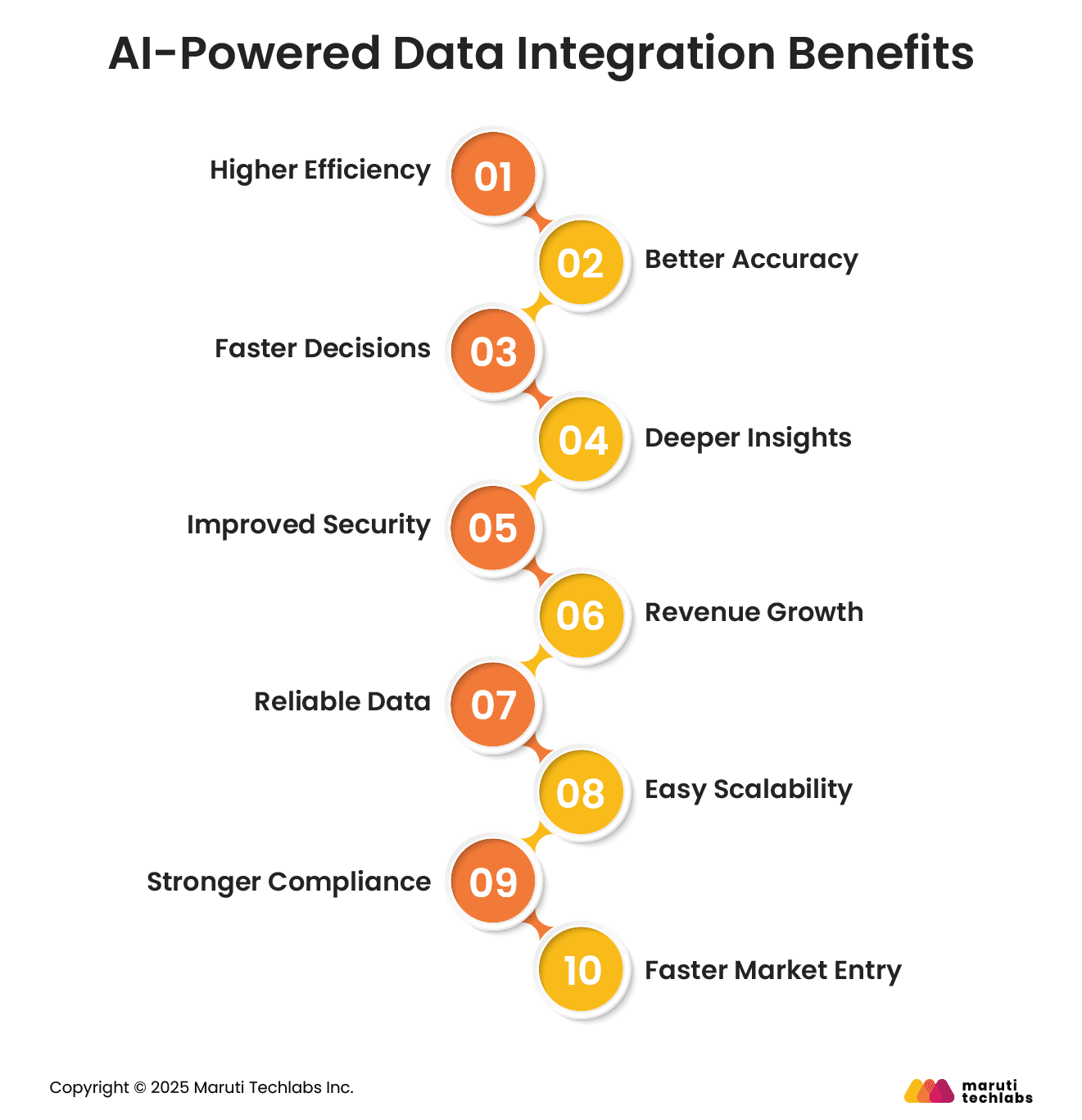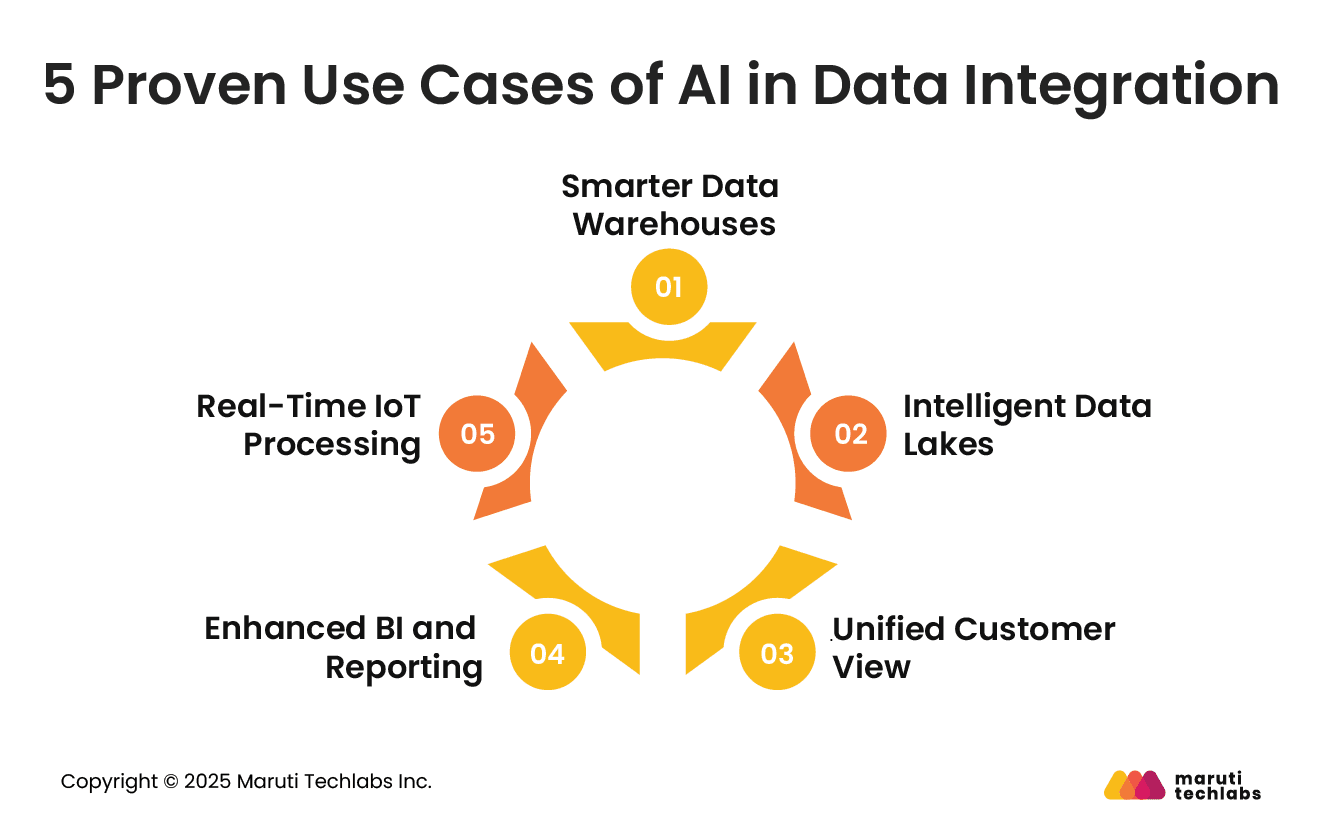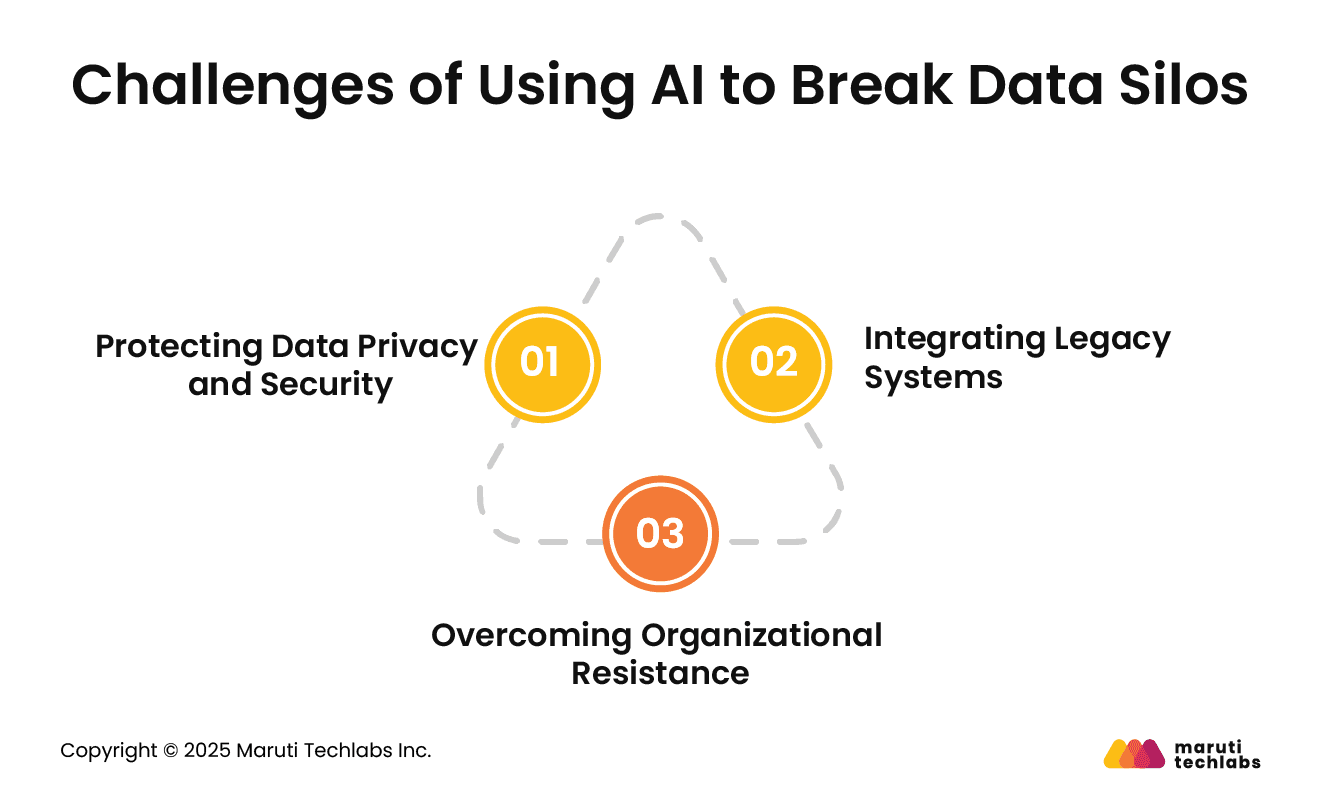

How AI Unifies Data Silos: A Practical Guide for Modern Enterprises






Data silos are one of the most common bottlenecks enterprises face today. When information is scattered across departments, systems, or tools, it becomes difficult to access, slows down processes, and often leads to missed opportunities. In fact, these silos silently drain revenue by preventing teams from seeing the complete picture of their business.
This is where AI-powered data integration comes in. By combining artificial intelligence with integration processes, enterprises can connect fragmented data, automate routine tasks, and improve the accuracy of insights. The result is greater efficiency, stronger data privacy, and smarter decision-making.
The numbers tell the story, too. Global spending on AI is expected to more than double by 2028, reaching $632 billion. At the same time, there are nearly 58,000 AI companies worldwide, with one-fourth of them based in the US, showing how quickly AI is reshaping how businesses manage data.
In this blog, we’ll explore how enterprises are using AI data integration to unlock data silos. We’ll cover the challenges data silos create, how AI-powered integration works, its benefits, 12 specific ways AI supports integration, five proven use cases, and the challenges enterprises must prepare for.
Enterprises thrive on data, yet silos frequently disrupt the flow. A data silo forms when information is locked within a single department or system, making it inaccessible to other departments or systems. For example, sales, marketing, and customer service teams may each collect valuable data. Still, if these systems don’t talk to each other, leaders miss out on a complete picture of the business.
This lack of connection causes real problems. Teams often duplicate efforts, reports become inconsistent, and essential opportunities slip through the cracks. Decision-making slows down because leaders cannot rely on unified, accurate insights. In short, valuable information stays trapped in isolated pockets instead of driving growth.
Breaking down silos is critical to unlocking the full power of data. With AI-powered integration, businesses can bridge these gaps, unify their systems, and ensure that data works together to support strategy and inform smarter decisions.
Businesses today deal with massive amounts of data, but traditional methods often struggle to handle unstructured or semi-structured information. This leads to errors, delays, and wasted resources. AI is transforming the way integration works by automating tasks, enhancing accuracy, and facilitating the extraction of valuable insights.
AI supports decision-making through machine learning (ML), which uncovers patterns and relationships in large datasets that humans often overlook. It can identify inconsistencies, automatically organize data, and eliminate bottlenecks. This means less manual work and more reliable results.
Another key area is natural language processing (NLP), which interprets text from reports, emails, and customer conversations. By combining this data, businesses gain richer context and sharper insights for decision-making.
AI also uses predictive analytics to look at past data and forecast what might happen next. This helps businesses plan, avoid risks, and make smarter decisions in areas such as supply chain management and customer engagement.
Ultimately, process automation driven by AI minimizes errors in data entry, validation, and corrections. It also improves security by detecting unusual activity early and protecting data from threats.
The following are the key benefits businesses can achieve with AI-powered data integration:

AI can make every step of the data integration process smarter, faster, and more reliable. Here’s how it helps:
1. Smart Data Capture – AI automatically pulls data from databases, APIs, files, or even social media, reducing manual work and errors while speeding up collection.
2. Data Understanding – By spotting patterns and anomalies, AI quickly shows the quality and structure of data. It also auto-generates metadata to improve transparency.
3. Data Cleanup – AI detects duplicates, missing values, and inconsistencies, then fixes them. It also standardizes formats, ensuring data remains consistent across systems.
4. Field Matching – AI learns from past mappings to automatically link fields between systems. It also suggests the best matches to speed up integration.
5. Data Shaping – AI creates transformation rules based on patterns and business needs. It can also enrich records in real time with external data.
6. Smooth Data Loading – AI optimizes how data is loaded by adjusting to system performance and handling errors on the fly to keep processes running.
7. Seamless Merging – When data overlaps, AI resolves conflicts and removes duplicates, ensuring one accurate and clean dataset.
8. Storage Optimization – AI predicts usage and tiers storage. Frequently used data stays in faster systems, while less-used data moves to cost-effective storage.
9. Easy Data Access – AI tailors dashboards and reports to each user’s needs. With natural language queries, anyone can ask questions and get instant answers.
10. Quality Monitoring – AI continuously checks for errors or unusual patterns. Predictive checks even flag potential issues before they disrupt operations.
11. Governance Automation – AI enforces rules automatically, adjusts access controls based on sensitivity, and ensures compliance without slowing down workflows.
12. Process Documentation – AI generates and updates documentation, keeping metadata and process records accurate and easy to track.
By supporting each stage, AI-driven integration boosts efficiency, ensures reliable data, and empowers businesses with insights they can trust.
AI-powered integration is not just theory; it’s already helping businesses in practical ways. Here are five proven use cases:

AI automates the extraction, transformation, and loading (ETL) of data into warehouses. It also detects patterns and anomalies during aggregation, making reports and analytics more accurate and reliable.
AI makes it easier to move and organize structured, semi-structured, and unstructured data into data lakes. It improves tagging, classification, and quality checks while enabling advanced analytics and predictive modeling.
AI brings together data from CRM systems, marketing tools, and support platforms to build a complete 360° customer profile. Machine learning then analyzes this data to predict behaviors, personalize experiences, and support cross-sell and upsell strategies.
By pulling data from multiple sources, AI creates richer dashboards and reports. It goes beyond surface-level numbers to uncover hidden trends, while NLP tools make summaries easy to read for non-technical users.
With AI, data from IoT devices can be processed instantly. This supports predictive maintenance, anomaly detection, and automated responses—helping businesses improve efficiency and make faster, smarter decisions.
In each of these cases, AI enhances data integration by reducing manual work, improving accuracy, and turning raw data into actionable insights.
While AI brings powerful opportunities to unify data and drive analytics, organizations often face hurdles during implementation. These challenges usually fall into three key areas:

When data flows freely across departments, privacy and security risks rise. Strong governance practices such as access controls, audit trails, and anonymization are essential. Compliance with regulations like GDPR and CCPA is also critical. AI-powered governance tools support this by automatically tagging sensitive data and enforcing protection measures.
Many businesses still rely on legacy systems that don’t easily connect with modern platforms. AI can ease this by enabling “data virtualization,” which provides unified access without moving data. Other tools, such as RPA and semantic layers, can bridge the gap, making historical data accessible without replacing critical systems.
Often, the toughest barrier is organizational. Teams may hesitate to share data, distrust AI-driven insights, or cling to long-standing processes. Overcoming this requires executive sponsorship, clear communication of benefits, early proof-of-value projects, and structured training. Equally important is fostering cross-team collaboration alongside solving the technical challenges.
By addressing these challenges, organizations can unlock the full value of AI-driven data integration.
The true value of analytics lies not in generating endless reports, but in delivering insights that help businesses act with confidence. As enterprises continue to collect data from multiple systems, the challenge is no longer about having enough data—it’s about unifying it in a way that drives better decisions.
AI plays a key role in solving this challenge. Breaking down silos enables businesses to consolidate information from across departments and systems into a single, unified view. With this foundation, Generative AI can surface patterns, predict outcomes, and provide clear recommendations that improve decision-making, boost efficiency, and enhance the overall customer experience.
Of course, the journey to AI-powered data unification requires careful planning, the right technologies, and organizational alignment. But for businesses that embrace this shift, the rewards are significant: faster insights, smoother operations, and stronger customer relationships.
If your organization is looking to turn siloed data into actionable intelligence, our team at Maruti Techlabs can help. Explore our AI services or get in touch with us to discuss how we can support your data integration journey.
Not sure where to begin? Use our AI Readiness Calculator to assess your organization’s current maturity level and identify the right steps toward AI-driven data unification.
Top-rated AI data integration platforms include Talend, Informatica, Fivetran, IBM DataStage, and Microsoft Azure Data Factory. These platforms use AI-driven automation for faster data mapping, cleansing, and transformation. They help businesses integrate data from multiple sources, ensuring accuracy, consistency, and scalability for better insights and decision-making.
AI enhances data collection by automating information gathering from diverse sources like websites, sensors, and applications. It improves accuracy through anomaly detection and filters irrelevant data.
Machine learning algorithms further optimize processes, reducing manual effort while ensuring clean, structured, and high-quality datasets for advanced analytics and predictive modeling.
Integrating AI into data analysis involves combining machine learning models with existing analytical workflows. AI automates pattern detection, predictive analytics, and anomaly identification.
Tools such as Python libraries, cloud platforms, and business intelligence software facilitate integration. This enables organizations to uncover deeper insights, make faster decisions, and improve overall accuracy.
Data silos are isolated storage systems where information is inaccessible to other departments. They hinder collaboration and limit insights. Data integration unifies these silos by connecting multiple sources into a centralized system, ensuring accessibility, consistency, and accuracy.
AI enhances data management by automating classification, cleansing, and governance processes. It identifies inconsistencies, ensures compliance, and strengthens security.
AI-driven tools streamline metadata management, improve data quality, and support predictive analytics. This reduces manual workload, increases operational efficiency, and enables businesses to manage large datasets more effectively and intelligently.


